The Athlon 2 X2 250 and Phenom 2 X2 550 BE are great price/performance CPU’s that offer a good punch for a great price. See what we achieved with them on an $85 motherboard.
INTRODUCTION
AMD has been fielding new CPU’s faster than any other company has in recent history. They are unveiling the Phenom 2 X2 550 BE and Athlon 2 X2 250 at Computex (2009). Two new reasonably priced dual core CPU’s that promise to be excellent values as well as promising to be good overclocker chips. Coming in at 3.0 GHz on the Athlon 2 X2 250 and 3.1 GHz on the Phenom 2 X2 550 they provide enough speed out of the box for most mainstream users and the overclockability of the new 45nm CPU’s promises enough excitement for the overclocker crowd.
With new lost cost alternative motherboards like the Gigabyte 770T-UD3P coming in at around $85 USD and overclocking like a champion you can be setting on a Motherboard/CPU combination for around $170 – 180 depending on the CPU you choose. Not to shabby for a nice fast dual core setup but how will they compare to existing CPU’s like the E8400? Well we don’t expect a chip that cost $102 to compete with a chip that cost $160 but it would be nice if the new Athlon 2 and Phenom 2 CPU’s perform at enough of a level to compete with chips like the E7400 and provide a cost friendly alternative to more expensive Intel rigs.
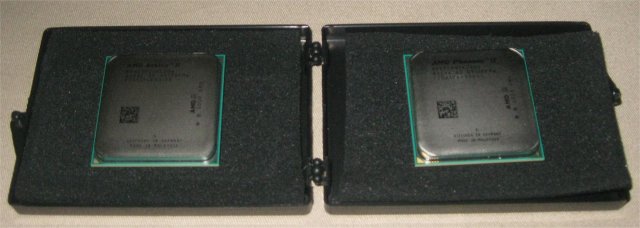
About AMD
Advanced Micro Devices (NYSE: AMD) is an innovative technology company dedicated to collaborating with customers and partners to ignite the next generation of computing and graphics solutions at work, home, and play.
Vision
A world where the amazing power of AMD technology improves the quality of people’s lives.
AMD set a goal to enable affordable, accessible Internet connectivity and computing capabilities for 50 percent of the world’s population by the year 2015. Learn more about AMD’s 50×15 Initiative.
Mission
Lead through innovative, customer-centric solutions that empower businesses, enhance the digital lifestyle, and accelerate global digital inclusion.
Values & Beliefs
AMD’s culture is characterized by an indomitable will to succeed and prosper in one of the world’s most challenging industries. At the heart of our unique and strong culture is the belief that people are the ultimate source of our competitive advantage. By living these core values, each one of us helps to deliver on our promises to customers, maximize shareholder value and ensure our enduring success.
Respect for People
We respect people, honor diversity and treat each other fairly. These are the cornerstones of our culture and key to our ability to work successfully as a global team. Learn about what it’s like to work at AMD.
Integrity
We operate with the highest standards of honesty and responsibility—as individuals and as a corporation—to be a role model worldwide through our business practices, community involvement and environmental stewardship. View our corporate responsibility mission and achievements.
Our Customers’ Success
We ensure our customers’ ongoing success by forging deep relationships founded on our commitment to meet their diverse technology needs and a shared passion for excellence. Read about how AMD drives customer success.
Customer-Centric Innovation
We lead through innovation—championing creative ideas and solutions that enable our customers to truly differentiate their solutions in the marketplace.
Initiative and Accountability
We deliver on our promises to our customers, stakeholders and to each other by taking risks, seeking proactive solutions and assuming ownership of the results.
At AMD, we take a measured approach to evaluate and continually improve global environmental efficiency, from how we run corporate facilities to how we develop products that deliver superior performance-per-watt. Learn more about AMD’s Green initiative at: www.amd.com/climate.
Fair and Open Competition
We believe that fair and open competition places the freedom of choice in the hands of customers, allowing the widest population to have access to the best possible technology.
SPECIFICATIONS
Lets start this section with a table showing a bunch of CPU’s then move onto individule specifications
| AMD CPU Specs | ||||||||
| Model | Clock Speed | System Bus Speed | Package Profile | Voltage | Max Temp | TDP | Total L2 Cache | Total L3 Cache |
| Phenom 2 X2 550 BE (45nm) | 3.1 GHz | 4.0 GT/s | Socket AM3 | 0.875-1.425v | 65°C | 80w | 2MB | None |
| Athlon 2 X2 250 (45nm) | 3.0 GHz | 4.0 GT/s | Socket AM3 | 0.875-1.425v | 70°C | 65w | 1MB | 6MB |
| 940 X4 (Black Edition) | 3.0 GHz | 3.6 GT/s | Socket AM2+ | 0.875-1.5v | 62°C | 125w | 2MB | 6MB |
| 920 X4 | 2.8 GHz | 3.6GT/s | Socket Am2+ | 0.875-1.5v | 62°C | 125w | 2MB | 6MB |
| 810 X4 | 2.6 GHz | 4.0 GT/s | Socket Am2+ or AM3 | 0.875-1.425v | 71°C | 95w | 2MB | 4MB |
| 910 X4 | 2.6 GHz | 4.0 GT/s | Socket Am2+ or AM3 | 0.875-1.425v | 71°C | 95w | 2MB | 6MB |
| 805 X4 | 2.5 GHz | 4.0 GT/s | Socket Am2+ or AM3 | 0.875-1.425v | 71°C | 95w | 2MB | 4MB |
| 720 X3 (Black Edition) | 2.8 GHz | 4.0 GT/s | Socket Am2+ or AM3 | 0.875-1.425v | 73°C | 95w | 2MB | 6MB |
| 710 X3 | 2.6 GHz | 4.0 GT/s | Socket Am2+ or AM3 | 0.875-1.425v | 73°C | 95w | 2MB | 6MB |
The biggest differences between the Phenom 2 X2 550 and Athlon 2 X2 250 are the Athlon 2 has no L3 cache and it uses 65 Watts and the Phenom 2 uses 95w. The Athlon 2 also has a much smaller die size the Athlon two is 117.5 mm2 and the Phenom 2 is 258 mm2 more than twice the size of the Athlon 2.
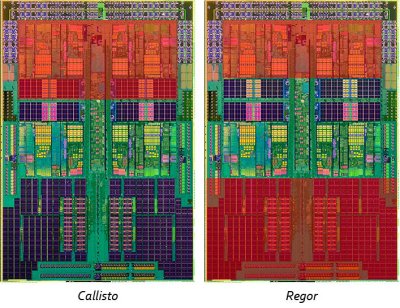
Pictured here the Phenom 2 X2 550 BE is the Callisto core and the Athlon 2 X2 350 is the Regor core. It quickly becomes apparent that they are almost identical in design and the Callisto core has the same L2 Cache as the Regor but half of it is disabled. The Regor Core has the Same L3 cache but it is also disabled. The most reasonable explanation for this is core harvesting which is the process of taking higher end CPU’s that didn’t make the grade and harvesting them for other uses. This is a common practice in CPU production and has been practiced by Intel and AMD for years.
Athlon 2 X2 250
| AMD Athlon II X2 250 (AM3 Package Backwards Compatible AM2+) Specifications |
|
| Processor Frequency | X2 250 = 3.0 GHz |
| Cache Sizes | L1 Cache Sizes: 64K of L1 instruction and 64K of L1 data cache per core (256KB total L1 per processor)
1MB of L2 data cache per core (2MB total L2 per processor) L3 Cache Sizes: None |
| HyperTransport 3.0 Link | One 16-bit/16-bit link @ up to 4.0 GHz full duplex (2.0GHz x2) |
| HyperTransport 3.0 Bandwidth | Up to 16 GB/s |
| Total Processor Bandwidth | Up to 33.1GB/s GB/s total bandwidth |
| Packaging | Socket AM3 938-pin organic micro pin grid array (micro-PGA) |
| Fab location | GLOBALFOUNDRIES Fab 1 Module 1 |
| Process Technology | 45-nanometer DSL SOI (silicon-on-insulator) technology |
| Approximate Transistor count | ~ 234 million (45nm) |
| Approximate Die Size | 117.5 mm2 (45nm) |
| Max Ambient Case Temp | 74o Celsius |
| Nominal Voltage | 0.85 – 1.425 Volts |
| Max TDP | 65 Watts |
| NOTE: * MC configurable for dual 64-bit channels for simultaneous read/writes **NOTE: for DDR3-1333, AM3 boards will support 1-DIMM-per-channel @ 1333MHz |
|
With a maximum TDP of 65 watts the Athlon 2 X2 250 is ideal for a HTPC setup, midrange destop and for a dual core 3 GHz games pretty well. We’ll have to get into benching to see how the lack of an L3 cache affects performance.
Phenom 2 X2 550
| AMD Phenom II X2 (AM3 Package Backwards Compatible AM2+) Specifications |
|
| Processor Frequency | X2 550 BE = 3.1 GHz |
| Cache Sizes | L1 Cache Sizes: 64K of L1 instruction and 64K of L1 data cache per core (256KB total L1 per processor)
L2 Cache Sizes: 512KB of L2 data cache per core (1MB total L2 per processor) L3 Cache Sizes: 6MB (shared) |
| HyperTransport 3.0 Link | One 16-bit/16-bit link @ up to 4.0 GHz full duplex (2.0GHz x2) |
| HyperTransport 3.0 Bandwidth | Up to 16 GB/s |
| Total Processor Bandwidth | Up to 37.3 GB/s total bandwidth |
| Packaging | Socket AM2+ 940-pin organic micro pin grid array (micro-PGA) or Socket AM3 938-pin organic micro pin grid array (micro-PGA) |
| Fab location | GLOBALFOUNDRIES Fab 1 Module 1 |
| Process Technology | 45-nanometer DSL SOI (silicon-on-insulator) technology |
| Approximate Transistor count | ~ 758 million (45nm) |
| Approximate Die Size | 258 mm2 (45nm) |
| Max Ambient Case Temp | 70o Celsius |
| Nominal Voltage | 0.875 – 1.425 Volts |
| Max TDP | 80 Watts |
| NOTE: * MC configurable for dual 64-bit channels for simultaneous read/writes **NOTE: for DDR3-1333, AM3 boards will support 1-DIMM-per-channel @ 1333MHz |
|
Having a 6 MB L3 cache and a TDP of 80 watts makes the Phenom 2 X2 550 BE a good choice for the dual core crowd that likes to overclock and the unlocked multiplier at the expected market price of $102 (USD) doesn’t hurt our feelings any.
PICTURES & IMPRESSIONS

When we get CPU’s their usually delivered in non-standard packaging without a lot of fanfare. That’s okay with us but we’d like to see the stock CPU coolers these will ship with so we could give you an idea of how well that is going to work for you. We recommend aftermarket cooling on most CPU’s but we’d like to see and run them so it will give you an idea of what your looking at when you purchase one of these beasts retail.
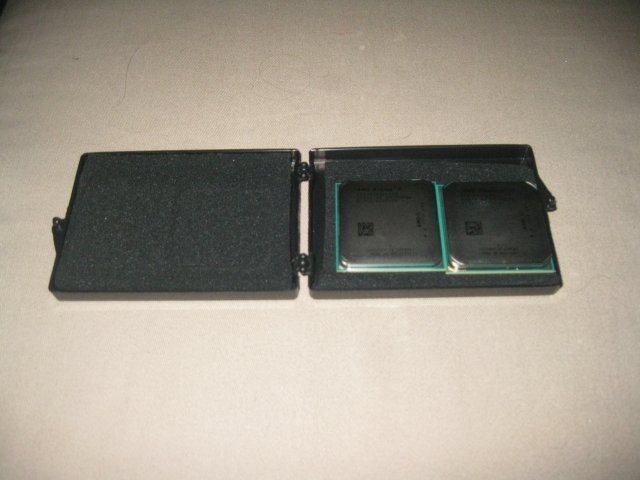
Inside the box cradled in protective foam we find the Athlon 2 and Phenom 2 X2 variants we’ll be looking at today. There’s nothing like the smell of fresh chips burning in, in the morning.
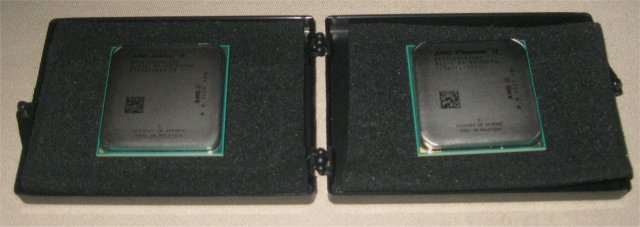
We don’t really like to handle the chips very much except to put them in the machine and run them, you’ll need to be careful of the pins on the bottom because unlike older generation CPU’s these sport very small fragile pins. We didn’t have a problem with them ourselves but bending a few of them would be catastrophic.
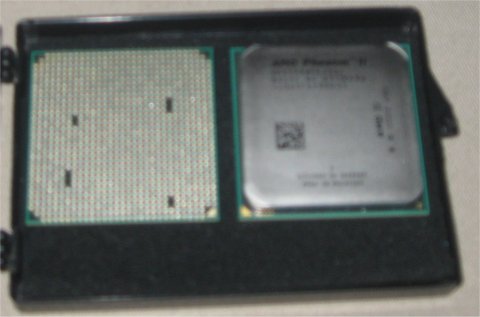
Standard AM3 pin layout on both the CPU’s and they should be backwards compatible with AM2+ boards if the vendor has allowed for it with a BIOS update.

Here’s a little better shot of the back of the CPU. Both CPU’s feature the same pin configuration.

From the top the CPU’s are identical except for the writing on the heatspreader.

The Phenom 2 X2 550 BE is a little exciting for us, we don’t get to look at many unlocked multiplier CPU’s, and this is the first Dual Core Black Edition we’ve had hands on. With the expected release price of $100 it’s an affordable luxury you should consider. If you’ve never experienced the joys of an unlocked multiplier CPU you should treat yourself to one at least once in your life. It not only offers easier overclocking but is good for older boards that don’t overclcok well with a HT (FSB) OC.
TESTING & METHODOLOGY
To test the 2 CPU’s we did a fresh load of Vista 64 and applied all the latest patches and updates. We also updated the motherboard drivers to the latest versions and checked to make sure we were using the latest BIOS. Once we had all the patches installed, motherboard drivers up to date, and all the little things that need to be done to bring a system up to snuff, we cloned the drive using Acronis to keep the load safe from any little overclocking accidents we might have.
On this review in particular, the overclocks we managed are more a reflection of the amount of time that we had to spend with the product before the NDA (Non-disclosure agreement) lifts than the equipment itself. By that we mean two weeks spent with the New CPU’s (two of them) and a new never before used motherboard isn’t enough time to say, “These are the maximum OC’s we achieved and we believe that these are the best overclocks we can get.” We know they’re not the best OC’s we can get but they are the best OC’s we can get in the allotted time we had with the product before it was time to post the review. With more time and experience on the platform and motherboard we know we can achieve higher overclocks (Given better CPU Cooling) so please take that into consideration.
Test Rigs
We decided that since no matter what we do or say that the information about the review of Intel and AMD CPU’s people are going to look at them side by side and draw conclusions. To that end we used the same CPU cooler on all of the CPU’s. We used the Thermalright Ultra 120 with the same two fans for every CPU. We also used the Intel 80 GB Solid State Drive for every CPU reviewed.
We used the same hard drive, same CPU cooler, and same GPU on all the platforms in an attempt to make the data as relevant as possible. We don’t think that it would be a fair comparison to use a high end SSD on the Intel platform and one of the top CPU coolers without extending the same courtesy to the AMD platform. To do so would make it a lopsided review and bias the numbers. So if you browse other CPU reviews one of the things you should be looking for and asking yourself is, “Did the site use the same hardware for all the CPU’s or did they use a lot of different hardware and just throwing the numbers out there?” If they did, it will make a tremendous difference in the platform numbers. We tested with and without SSD and the difference was large enough to invalidate data obtained using a platter drive against an SSD. To that end, we used the same hard drive, CPU cooler, and GPU on all of the CPU’s contained in this review.
Hardware Common To All The Test Rigs
- Thermaltake Tough Power 1200 Watt
- Intel 80 GB SSD
- Palit 4870×2 & BFG GTX-260 216 (The 260 216 is used for Vantage every other test is with the 4870×2)
- Razer Lycosa
- Razer Lachesis
- Top Deck Testing Station Chassis
- Thermalright Ultra 120 w/2 83CFm Yate Loon Fans
- LG DVD/RW
So you can pretty much see that the only platform differences are going to be Motherboard, CPU, and RAM. In a cross platform test that’s about as good as you can get.
Platform Specific Hardware
- Phenom 2 X2 550 BE & Athlon 2 X2 250
- Gigabyte 770T-UD3P ($85 (USD) Motherboard)
- Kingston HyperX DDR3 4 GB kit of 1600 MHz 9-9-9-28
Notice for comparison purposes we are running the Phenom 2 X2 550 BE and Athlon 2 X2 250 on exactly the same paltform with only the CPU’s being switched.
- Phenom 2 X4 955 BE CPU Equipment
- Asus M4A78T-E
- Kingston HyperX DDR3 1600 (Run at 1333) 4 GB Kit
- For more information on the Asus M3A78-T you can visit the Asus Website Here
- Phenom 2 X4 940 BE CPU Equipment
- MSI DKA790GX Platinum
- Crucial Ballistix DDR2 1066 4 GB Kit
- For more information on the MSI DKA790GX Platinum you can visit the MSI Website Here
- Phenom 2 X4 810 and X3 720 BE CPU Equipment
- Asus M3A78-T
- Crucial Ballistix DDR2 1066 4 GB Kit
- For more information on the Asus M3A78-T you can visit the Asus Website Here
- Intel Core I7 965 Equipment
- Asus P6T Deluxe
- Kingston HyperX Triple Channel DDR3 2 GHz
- For more information on the Asus P6T Deluxe you can see our review Here
- For more information on the Core i7 965 you can see our review Here
- Intel Q6600 Equipment
- EVGA 790I
- Crucial Ballistix DDR3 1333 4 GB Kit
- For more information on the EVGA 790I you can see our review Here
- Intel E8400 Equipment
- Gigabyte EP45-Extreme
- Crucial Ballistix DDR2 1066 4 GB Kit
- For more information on the Gigabyte EP45-Extreme you can read our review Here
Just in case you were wondering, yes, we have all those beautiful machines here in one spot, up and running, not in the configuration we used in this review but, yes ,they are all here in one spot running and fully functional, along with a stack of GPU’s that would make a grown man cry, and a stack of high end RAM that would make you pull your hair out, and a stack of high end Hard Drives that will make you drool. We were deprived as children. We had the Atari console. We’re making up for it now.
Before we move onto the Testing Suite section lets get this out of the way. We ran all the CPU’s at stock Speed during testing, then we ran the AMD CPU’s at the best OC we could get in the time we had. We already know that some people are going to yell because we didn’t OC the Intel CPU’s in the review. If you want to see the Intel overclocks and results of those we have separate reviews for three of the Intel Core I7 CPU’s, each one contains OC information and testing. Feel free to browse those and compare numbers to this review. You can spend half a lifetime OCing and charting results in all the possible combinations. We run each CPU at stock speed for comparison purposes, then the CPU being reviewed we OC that one. You might not even get an OC out of the same model CPU and unless it’s on the same board with the same RAM and the OC is done identically, the numbers won’t be the same.
Test Suite
|
Synthetic Benchmarks |
|
3DMark Vantage v. 1.01 |
|
3DMark06 v. 1.1.0 |
|
SiSoft SANDRA XII Professional SP2 |
|
Everst Ultimate Edition v. 4.50.1330 |
|
Cinebench R10 64 bit |
|
WinRar v. 3.71 |
3DMark Vantage
For complete information on 3DMark Vantage Please follow this Link: www.futuremark.com/benchmarks/3dmarkvantage/features/
The newest video benchmark from the gang at Futuremark. This utility is still a synthetic benchmark, but one that more closely reflects real world gaming performance. While it is not a perfect replacement for actual game benchmarks, it has its uses. We tested our cards at the ‘Performance’ setting.
Currently, there is a lot of controversy surrounding NVIDIA’s use of a PhysX driver for its 9800 GTX and GTX 200 series cards, thereby putting the ATI brand at a disadvantage. Whereby installing the PyhsX driver, 3DMark Vantage uses the GPU to perform PhysX calculations during a CPU test, and this is where things get a bit gray. If you look at the Driver Approval Policy for 3DMark Vantage it states; “Based on the specification and design of the CPU tests, GPU make, type or driver version may not have a significant effect on the results of either of the CPU tests as indicated in Section 7.3 of the 3DMark Vantage specification and white paper.” Did NVIDIA cheat by having the GPU handle the PhysX calculations or are they perfectly within their right since they own Ageia and all their IP? I think this point will quickly become moot once Futuremark releases an update to the test.
We swapped from the 4870×2 we used for most of the testing for the BFG GTX-260 Maxcore because we have the most data with the GTX-260 and for comparison purposes all the rigs need to run the same GPU. We also wanted to show that the Dragon platform would run Nvidia GPU’s as well as ATI GPU’s.
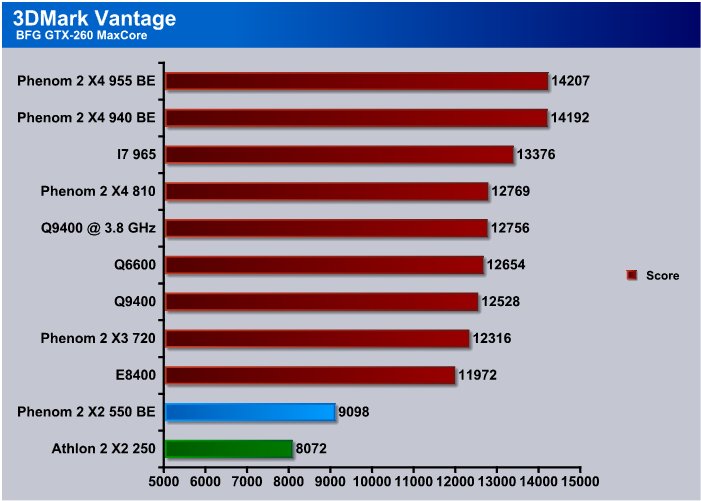
Here’s one of the problems with Vantage, the CPU score will kill the over all score. Vantage is geared toward Quad Core CPU’s and heavily multithreaded. All these scores are overall scores with no PhysX. The Athlon 2 X2 250 pulled a 10243 GPU score, 4934 CPU score. and the overall score was 8072. Most of the increases in scores are from the CPU scoring higher. The GPU scores on the rest of the CPU’s are about the same, in other words the Athlon and Phenom CPU’s are driving the card as hard as it will go, but the lower CPU score drags down the overall score and doesn’t do justice to it’s ability to drive a GPU.
Notice that the 100 MHz increase in speed on the Phenom 2 X2 550 BE and the extra L3 cache pushed an extra thousand points in this test.
Cinebench
“CINEBENCH is a real-world test suite that assesses your computer’s performance capabilities. MAXON CINEBENCH is based on MAXON’s award-winning animation software, CINEMA 4D, which is used extensively by studios and production houses worldwide for 3D content creation. MAXON software has been used in blockbuster movies such as Spider-Man, Star Wars, The Chronicles of Narnia and many more. MAXON CINEBENCH runs several tests on your computer to measure the performance of the main processor and the graphics card under real world circumstances. The benchmark application makes use of up to 16 CPUs or CPU cores and is available for Windows (32-bit and 64-Bit) and Macintosh (PPC and Intel-based). The resulting values among different operating systems are 100% comparable and therefore very useful with regard to purchasing decision-making. It can also be used as a marketing tool for hardware vendors or simply to compare hardware among colleagues or friends.”
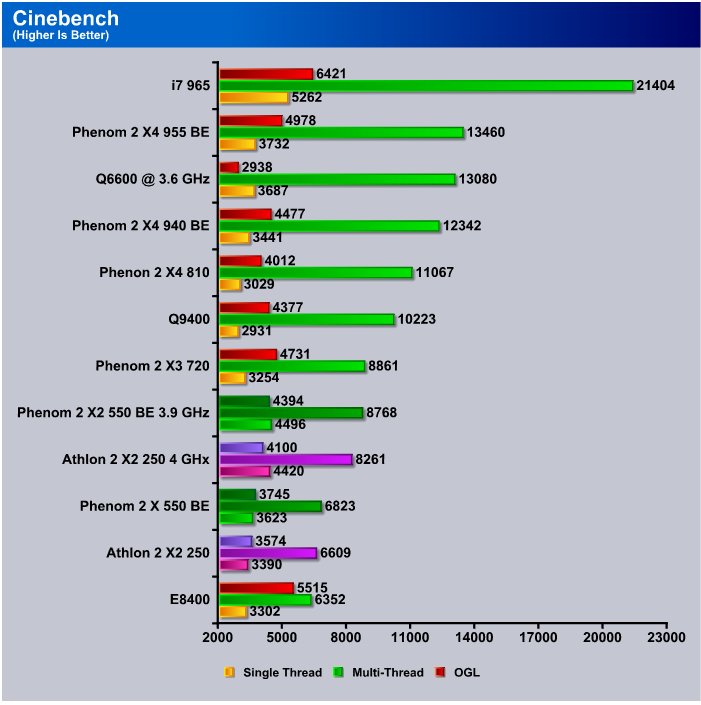
Here’s a suprize we ran into, in Cinebench the Athlon 2 X2 250 and Phenom 2 X2 550 BE came in ahead of the E8400 when running at stock speed. Price wise the two new AMD CPU’s fall in the E7XXX price range and compete with them directly on a performance level. We didn’t have one of the E7XXX CPU;s available to bench so we ran our old faithful E8400.

Both the new AMD CPU’s are showing a great CPU Ratio. The CPU ratio is the amount of efficiency your getting from the two cores of the CPU cooperating to get one job done. As the number of cores rise the efficiency goes down. Running at 1.95 and 1.94 these are highly efficient designs.
WinRar v. 3.71
This module in WinRar generates random data, which contains specially introduced redundancy, increasing the load to both the processor and memory. Data is then passed through RAR compression and decompression algorithms, and the output of the decompression algorithm is compared to the source data. If any differences are found, WinRAR then reports “Errors found – Yes” in the command window. WinRAR displays a size of processed data and compression speed, current and resulting, in kilobytes per second.
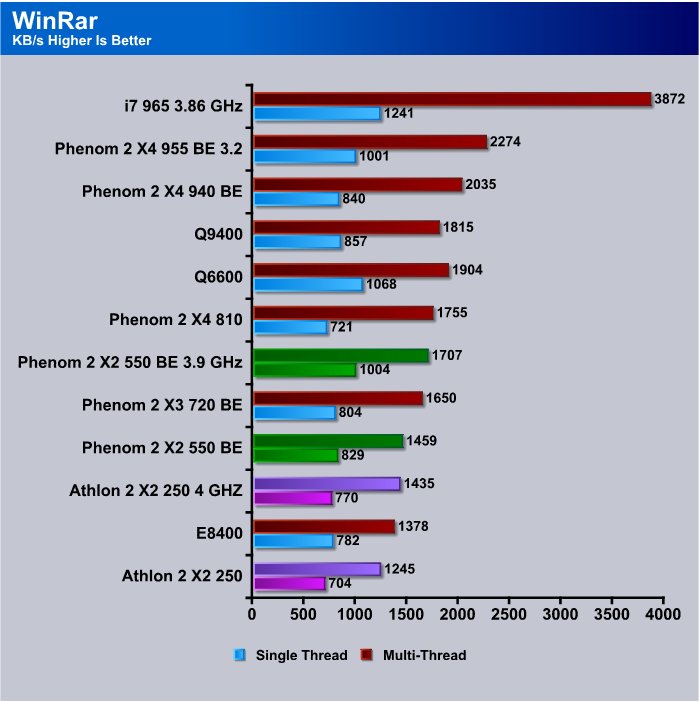
Here in WinRar we see the Athlon 2 X2 250 running just behind the E8400 at stock speed but the Phenom 2 X2 550 BE comes out ahead of the E8400 while running at stock speed. The Phenom 2 X2 came out ahead of the Athlon 2 X2 250 when the Phenom was running at stock speed and the Athlon 2 was overclocked to 4 GHz. When we put the overclock on the Phenom 2 X2 550 BE it walked away from the Athlon 2 X2.
EVEREST ULTIMATE
“EVEREST Ultimate Edition is an industry leading system diagnostics and benchmarking solution for enthusiasts PC users, based on the award-winning EVEREST Technology. During system optimizations and tweaking it provides essential system and overclock information, advanced hardware monitoring and diagnostics capabilities to check the effects of the applied settings. CPU, FPU and memory benchmarks are available to measure the actual system performance and compare it to previous states or other systems. Furthermore, complete software, operating system and security information makes EVEREST Ultimate Edition a comprehensive system diagnostics tool that offers a total of 100 pages of information about your PC.”
Everest Memory
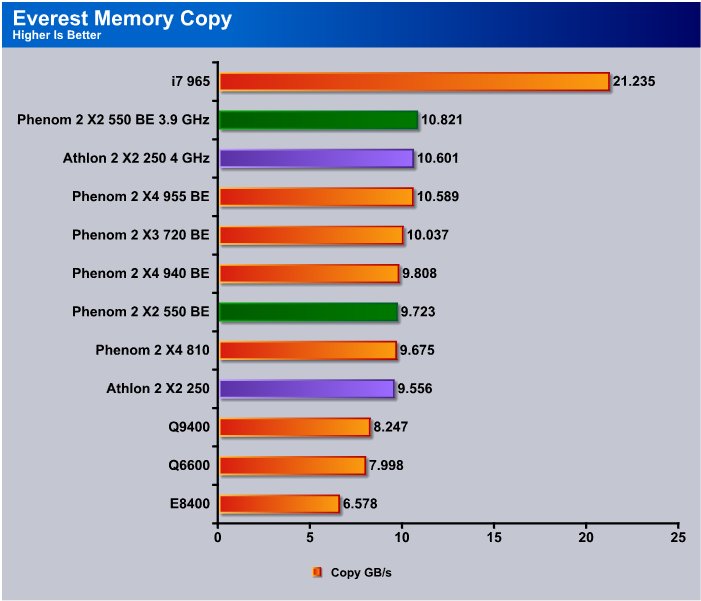
We’re running a 4 GB kit of Kingston HyperX DDR3 1600 at stock speeds on the Phenom 2 X2 550 BE while the CPU is at stock and OC speeds. The Athlon 2 X2 250 was running at 1600 at stock CPU speed and at the OC speed it was running in the 1400 MHz range.
AMD CPU’s are known to be more efficient at Dual channel memory operations than the LGA 775 platform and our testing reflects that. Both the AMD CPU’s come in well ahead of the LGA 775 platform at Stock CPU speed and when overclocked jump way out there.
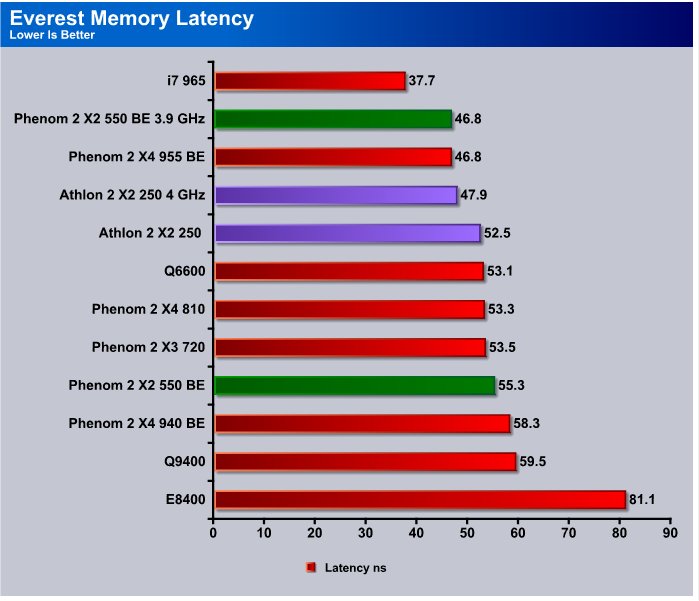
Running the same kit of ram it looks like the Athlon 2 X2 250 has some type of advantage with memory latency. The Athlon 2 comes in 7.5ns lower latency but the Phenom 2 X2 550 pulls ahead when overclocked.
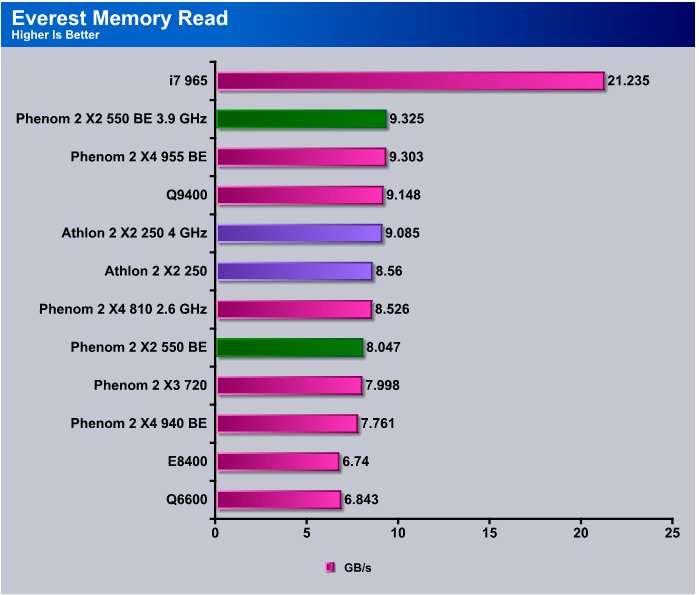
Here again in the Memory read test we see the Athlon 2 X2 ahead of the Phenom 2 X2 at stock CPU speed and when the Phenom 2 X2 is overclocked it pulls ahead.
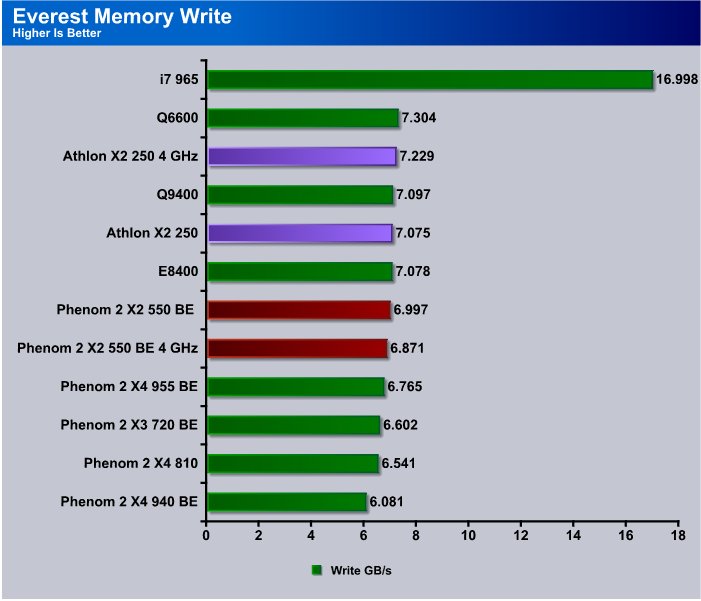
In the Write Speed the Athlon 2 X2 250 dominated the Phenom 2 X2 550 BE. The Phenom 2 X2 was coming in at 6.8 – 7 (Ish) GB/s and the Athlon 2 X2 250 was at 7+ GB/s.
Everest CPU
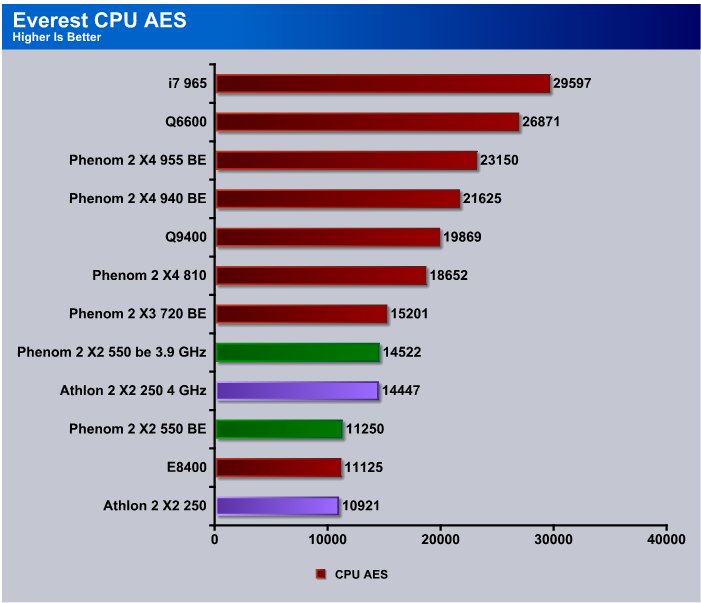
In the Everest CPU AES test we see the Athlon 2 X2 250 is competing with the E8400 closely. The Phenom 2 X2 550 BE beats the E8400 by a hair. Overclocking the two new AMD CPU’s shows us that they are scaling well with the core speed increase.

Photoworxx the Athlon 2 X2 250 fell a little short, probably due to a lack of L3 cache or difference in design, still this low cost jewel consuming only 65w TDP is a price performance Jewel. The Phenom 2 X2 550 BE fares better in photoworxx and at stock did better than the Phenom 2 X3 720, this would tend to indicate that phtoworxx isn’t heavily multithreaded.
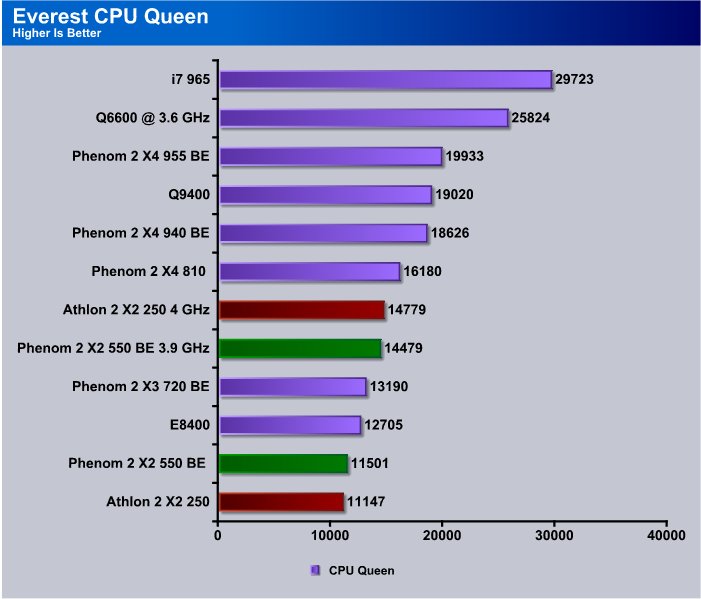
In CPU Queen the Athlon 2 and Phenom 2 come in below the E8400 which is at a considerably higher price point. Considering the E8400 cost 60% more then the Phenom 2 X2 we don’t have any complaints here. When we overclock the two AMD CPU’s they once again show good overclocking scaling.
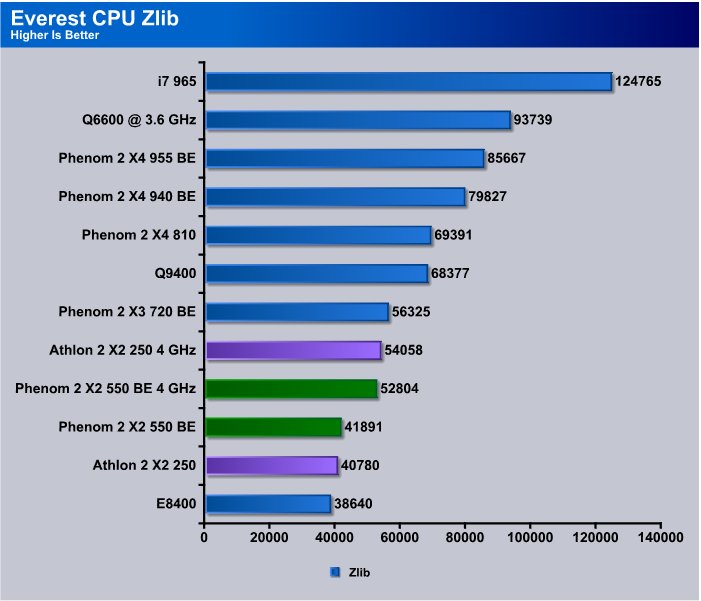
In Zlib both the new AMD CPU’s beat out the E8400 which is pretty good for two CPU’s that come in the $100 and sub $100 price range.
SANDRA 2009 SP1
Sisoft Sandra 2009 SP1
“SiSoftware Sandra (the System ANalyser, Diagnostic and Reporting Assistant) is an information & diagnostic utility. It should provide most of the information (including undocumented) you need to know about your hardware, software and other devices whether hardware or software. It works along the lines of other Windows utilities, however it tries to go beyond them and show you more of what’s really going on. Giving the user the ability to draw comparisons at both a high and low-level. You can get information about the CPU, chipset, video adapter, ports, printers, sound card, memory, network, Windows internals, AGP, PCI, PCI-X, PCIe (PCI Express), database, USB, USB2, 1394/Firewire, etc.”
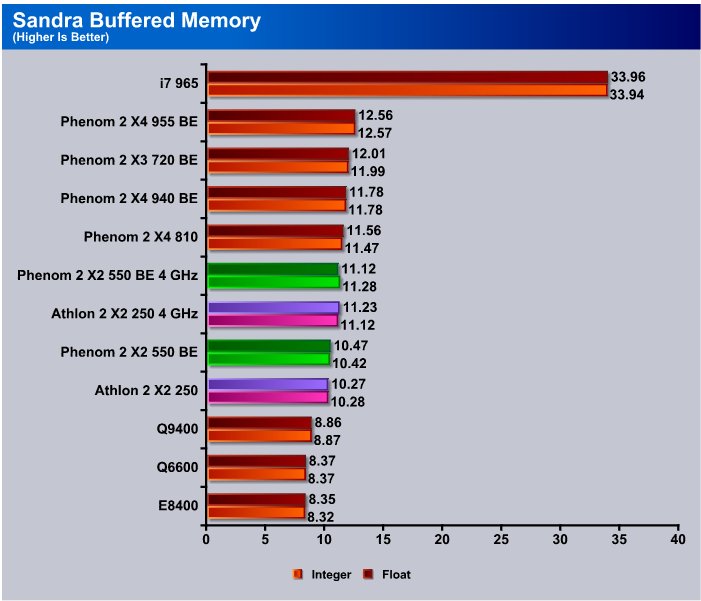
The Sandra Buffered Memory test once again shows the performance gain using AMD memory controlers for Dual Channel Memory over Intel LGA 775 memory controllers. The Phenom 2 X2 550 BE did a little better than the Athlon 2 X2 in this test.

In the Sandra Processor Multimedia test the new AMD CPU’s put out a pretty good price/performance level. When we overclocked the two they really show nice overclocking scaling.
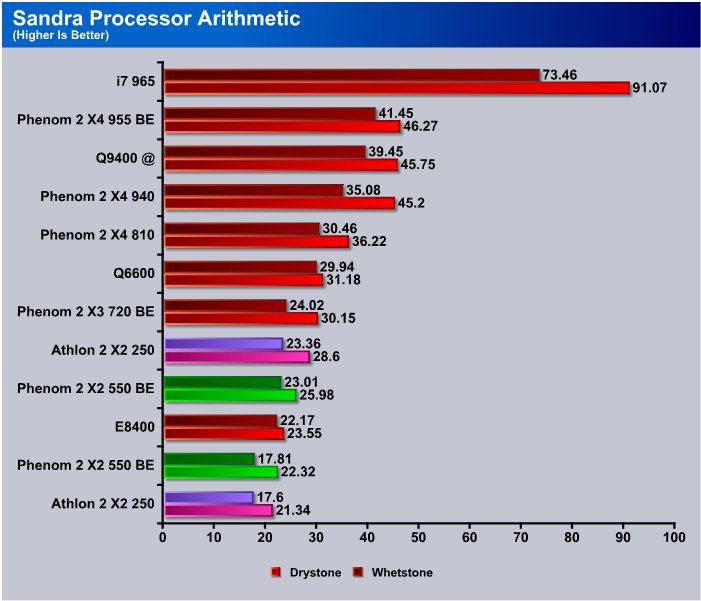
The processor arithmetic test sees the Phenom 2 X2 and Athlon 2 X2 coming in at 17.81 and 17.6 which is right in line with their price point placement. To expand a little further lets take a look at a couple of Sandra screen shots from the Athlon X2 250.
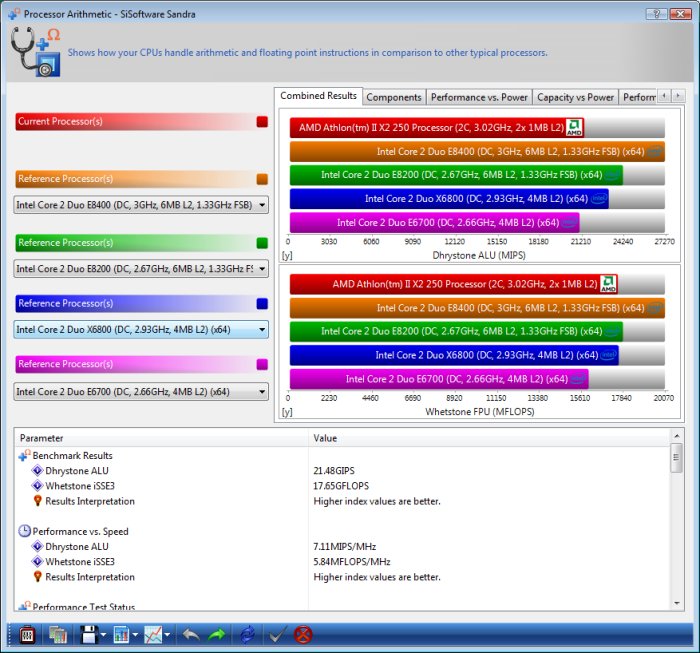
Comparing the AMD Athlon 2 X2 250 to the Intel offerings we see it running inline with the E6800 in the Drystone ALU test and in the Whetstone test it ranks up there with the E8200. Not bad for a couple of inexpensive dual core CPU’s. In our minds the few dollars more for the Phenom 2 X2 550 BE and it’s unlocked multiplier offers a little better value.
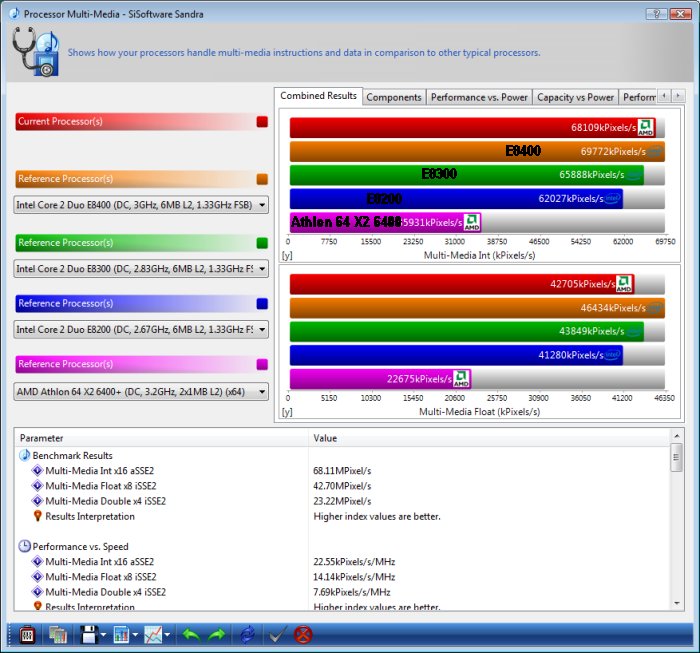
The Multimedia test shows the Athlon 2 X2 250 almost catching up to the E8400, and face it, a lot of the fun aspects of computing are the multimedia aspects, gaming, watching movies, and surfing the internet. When it comes to the fun aspect of computing AMD pumped up the new offerings.
We tossed an Athlon 64 X2 6400 previously the top of the line AMD Dual core in the Athlon lineup so you can see the generational gain. We purchased an Athlon 64 X2 6400 back in the day after a few price drops and paid a healthy $169 USD for it, in comparison out of the gate the Phenom 2 X2 550 BE come in $60 dollars cheaper, and the Athlon 2 X2 250 more than $70 dollars cheaper yet the Athlon 2 and Phenom 2 perform almost twice as fast. That’s price/performance on a whole new level.
Overclocking
Phenom 2 X2 550 BE
First lets take a look at the Phenom 2 X2 at stock settings on CPU-Z.
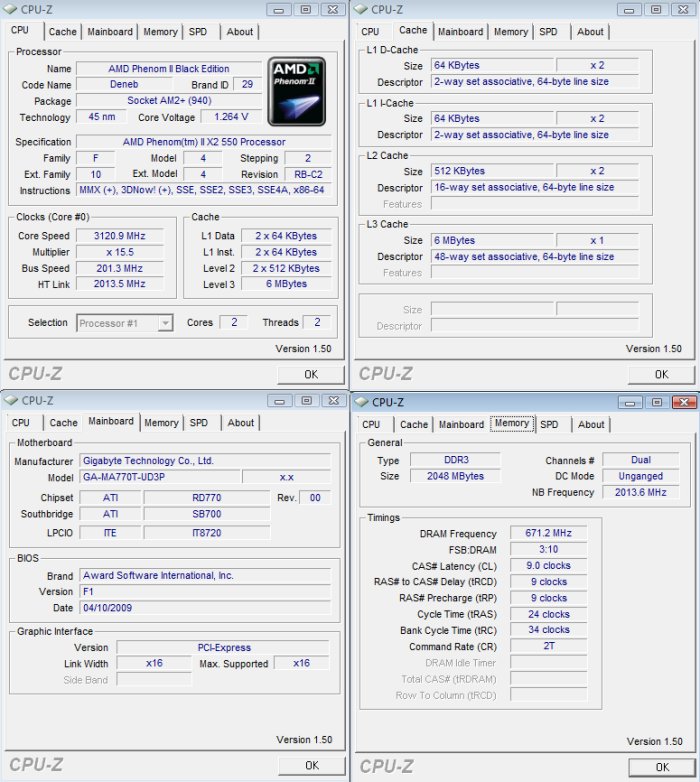
This is an early shot taken out of habit as soon as we loaded the machine so it’s showing the memory running at 1333. We pushed the Kingston kit up to 1600 MHz before testing. The Phenom 2 X2 550 BE comes in at 3.1 GHz out of the box but the Gigabyte board was running it at 201.3 Mhz Hypertransport so the CPU speed is showing 3120.9 MHz. The default multiplier is a little unusual and comes in at 15.5 but it’s unlocked for easy overclocking.
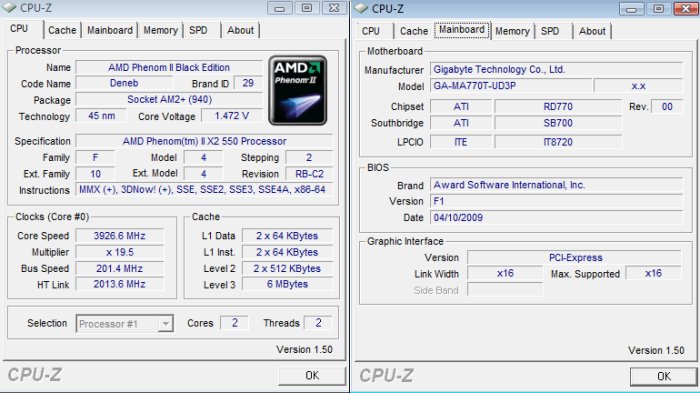
We managed to get the Phenom 2 X2 up to 3.92 GHz with little effort, attempts to go beyond that were fruitless. We did that on a Gigabyte MA770T-UD3P motherboard that runs $85 (USD). We could have used an extremely high end board (we have them on hand) but we wanted to depict the Phenom 2 and Athlon 2 CPU’s on a bargain board to show the powerful overclocking ability of the new CPU’s when combined with an affordable board. The most expensive CPU (we’re testing today) is the Phenom 2 X2 550 BE and it comes in at $102 and the board comes in at $85 so for $187 (at time of post) you have a killer overclocking combination that even the most value conscious enthusiast will love. We would have to give props to both AMD and Gigabyte for the successful overclock on this highly affordable platform. We’ve seen some other overclocking results on high end boards, the highest OC we’ve seen went about 60 Hz higher than ours, and the board used cost more than double what the Gigabyte MA770T-UDP3 cost. That’s good news in a couple of ways, the less expensive board overclocks well and the Phenom 2 X2 550 BE series has pretty consistent overclocking capabilities. Watch your voltage though these are 45nm chips and not as tolerant to overvolting as previous generations.
Athlon 2 X2 250
We left some settings on the Gigabyte MA770T-UD3P from testing with a different CPU, and forgot to clear CMOS before firing up the rig. Here’s what happened when we attempted to boot.
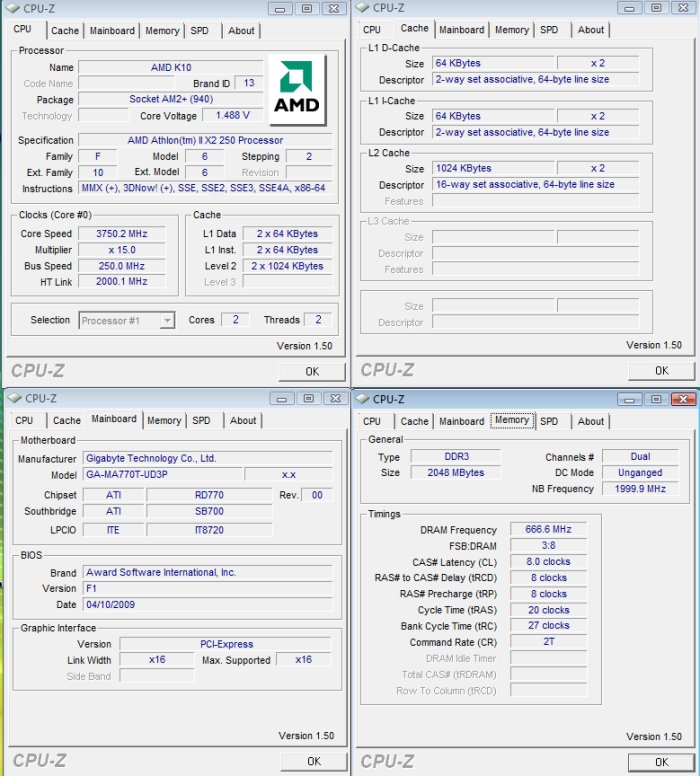
We had the HT speed set to 250 with a previous CPU testing the board to make sure it was functional, the Athlon 2 X2 250 booted right into Vista stable as a rock at 3.75 GHz. Pretty sweet.
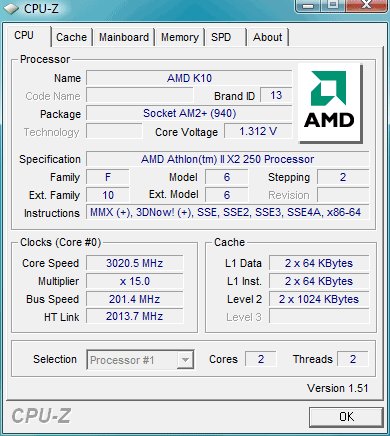
Once we booted into Vista at 3.75 we backed out to BIOS and saved the settings for later on the Gigabyte MA770T-UD3P and reset CMOS and booted in at the CPU’s default speed of 3 GHz. Notice the nice high multiplier of 15, that will help make this CPU an overclocking champ.
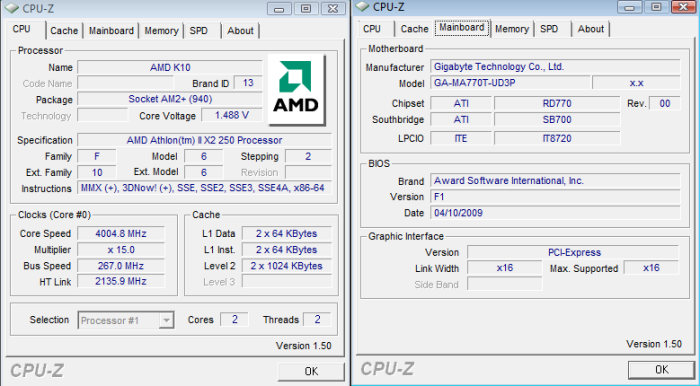
We reached a whopping 4 GHz on the Athlon 2 X2 250 with a paltry HT speed of 267 MHz. We were slightly over recommended voltage for the Athlon 2 X2 250 and it took 1.488 CPU-Z reading and 1.5v in BIOS. That’s pretty modest Vdroop for an $85 dollar Gigabyte board and one heck of an overclock for the combination.
We already know people are going to ask what settings we used. They always do. It’s different for every board and CPU our setting might work for you and they might not. We’d rather teach how to overclock than just give out freebie screenshots that will frustrate most of the readers.
All we did for the Phenom 2 X2 550 BE OC was increase the CPU multiplier to 19.5 and increase CPU voltage to 1.5v in BIOS and notched up the NB voltage one or two notches. That’s all we did and it Prime 95 tested stable for 4 hours straight and never once blue screened during testing across two full days of benchmarking and playing games. In case your wondering we played Crysis, Sacred 2 W/PhysX, and HawX and the machine never burped at high eye candy levels. The Phenom 2 X2 550 BE makes a good gaming rig.
For the Athlon 2 X2 250 all we did was increase the HT speed and increase the voltage to 1.5v then notched up the NB voltage a notch or two. On the Athlon 2 we cut a divider on the memory and let the CPU run at 4 GHz and the memory in the 1400MHz range. When it comes to overclocking CPU speed is king, but overclocking the CPU and memory together rules. We only had about 8 days lead time between product and review so we settled for CPU speed, so sue us for a great OC on two CPU’s in a limited time.
We also hooked up a Blu-Ray drive and both the CPU’s did very well in full HD 1080 playback. No stutters slow downs or degradation in playback so both should make exceptional HTPC CPU’s. We even played some Chess Titans in a window during HD playback (We’d seen the movie) and the machine did both tasks well showing that beyond HD playback both CPU’s have extra headroom for other tasks like watchin HD content and recording TV.
CONCLUSION
Both the Athlon 2 X2 250 and Phenom 2 X2 550 BE represent excellent value with a good balance of power. The CPU’s performed nicely in a variety of tests but we went beyond synthetic benchmarks and gamed with the CPU’s and did normal everyday activities for a couple of days after we got the benchmark numbers. The Athlon 2 X2 and Phenom 2 X2 game well and have more than enough power for a lot of end users. If your video editing or doing heavily multi-threaded applications that take good advantage of more than 2 cores you might want to look at a tri or quad core but for most end users these Dual core wonders will have more than enough power to surf the net, do schoolwork, game or playback HD content.
The Athlon 2 X2 250 being a 65w part with 234 Million transistors and no L3 cache, and having a locked multiplier put on a good show and gave the Phenom 2 X3 550 BE a good run for it’s money. If we had to recommend one over the other we’d have to bite our lip and say the Phenom 2 X2 550 BE will make a better all around CPU for almost every application except HTPC and for an HTPC the Athlon 2 X2 250 uses less power and also is the first AMD CPU to use on chip power saving hardware (C1E on chip). Moving the power saving features from in BIOS to on chip will have a better more consistent result across vendors.
We have been running the Athlon 2 X2 250 and Phenom 2 X2 550 BE for a couple of weeks now. The Athlon 2 X2 250 is a good chip but we have to look at a couple of things, performance price, ease of overclocking, number of transistors etc. As of last word from AMD on Sunday May 31st 2009, the MSRP on the Athlon 2 X2 250 is $87 (USD) and it has ~237 Million transistors and a locked multiplier. The Phenom 2 X2 550 BE out of the box is 100 MHz faster and has ~758 million transistors, sports an unlocked multiplier, only uses 15 watts more (TDP) than the Athlon 2 X2 250, and comes in at $102 (USD).
Now for HTPC usage that 15 measly watts might mean a lot, but with the Phenom 2 X2 550 BE coming in at $15 (USD) more than the Athlon 2 X2 and the Phenom 2 X2 has 521 Million more transistors in it we would recommend spending the extra $15 bucks for most people. If your doing light work and surfing the net or an HTPC then the Athlon 2 X2 will save a few bucks now and 15 Watts off the electric bill. Most reviewers and overclokers will enjoy the unlocked multiplier and higher out of the box speed of the Phenom 2 X2 550 BE.
With current Intel offerings running much much more expensive it would be hard to go wrong with an Athlon 2 X2 or Phenom 2 X2. Paired with a Gigabyte MA770T-UD3P (Retail approx $85) the Athlon X2 250 and board combo comes in at $172, toss on a good 4 GB kit of DDR3 and you in the $270 dollar range. Want to treat yourself to an Unlocked multiplier, pair the same board with the Phenom 2 X2 550 BE and your out ~$285. Less than the least expensive Core i7 CPU by itself, leaving enough money for a killer GPU and lightning fast HD and still you wouldn’t even put a big dent in a budget designed for a Core i7 rig.
We are liking the price performance ratio of the Athlon 2 X2 250 and Phenom 2 X2 550 BE, they won’t break the bank and provide enough power that your favorite games won’t lag. They overclock well, and overclocking is easy. Leave it to AMD to come up with a sleeper stratigy and have the right product at the right price at the right time. Kudos AMD!
We are using a new addition to our scoring system to provide additional feedback beyond a flat score. Please note that the final score isn’t an aggregate average of the new rating system.
- Performance 8.5
- Value 10
- Quality 9
- Warranty 8
- Features 9
- Innovation 9
Pros:
+ Great Price/Performance
+ Nice Overclocking Headroom
+ Responds Well To Advanced Cooling Methods
+ Best Price/Performance From AMD CPU’s We’ve Seen To Date
+ Very Stable When Overclocked Properly
+ Fun To Overclock Black Edition/Easy To OC Athlon 2
+ Motherboard/CPU/Ram Can Be Purchased For Less Than A Core I7 920
Cons:
– Not Recommended For People That Video Edit Or Use A Lot Of Applications That Are Heavily Multi-Threaded And Can Utilize A Quad.
The Athlon 2 X2 250 provides a good punch for an inexpensive Dual core and it’s big brother the Phenom 2 X2 550 BE delivers a knockout punch for price performance and the luxury of an unlocked multiplier so they both score an 8.5 out of 10 and the Bjorn3D Seal Of Approval.
 Bjorn3D.com Bjorn3d.com – Satisfying Your Daily Tech Cravings Since 1996
Bjorn3D.com Bjorn3d.com – Satisfying Your Daily Tech Cravings Since 1996





